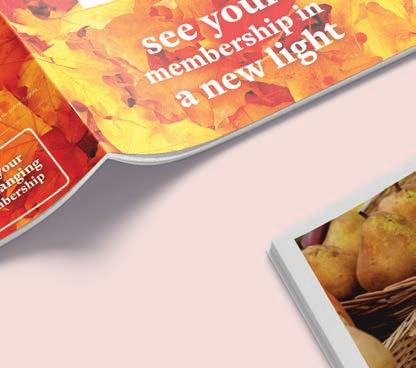uncorking potential
How producing a membership magazine unlocked one wine merchant's market

How to rise above the digital noise
What to look for in a magazine publisher
RHS case study
5 ways to improve engagement
We provide intelligent
We provide both printed communications and eDelivery alternatives to the membership sector and are proud to be partners to MemberWise.
We’re experts in member retention and acquisition, providing everything from data segmentation and enhancement, to planning campaigns, such as acquisition, gift aid, and legacy awareness. We have a strong track record of securing a real return on any project and campaign investment.
Our hybrid mail solution can help you reduce costs significantly by outsourcing your post-room and allowing your staff to work remotely, and can also be used for eDelivery. You can access large postal discounts by partnering with us.

Our services
• Member on-boarding and welcome packs • Fundraising and regular giving communications or charity based membership organisations • Membership cards, including Latcham Eco Card and 50% & 100% recycled PVC cards.
HelloWelcome to the second edition of Membership Magazine, a source of ideas, insights and inspiration for membership organisations. Our focus is on building long-lasting member relationships through member engagement.
In this issue, the team at Salt Media reveal how online merchant Wickhams Wine has used their customer magazine to uncork their marketing potential. And read on to find out how data, print and fulfilment partners Latcham help The Royal Horticultural Society tailor print and digital delivery to improve the organisation's service to its members.
We also look at how you can reduce your company's carbon footprint in a piece by auditing business Blue Marble, and Richard Gott of MemberWise explains how to improve member engagement via the membership experience.

I hope you find it useful.
Nick Cooper04 Uncorking potential: e Drop
08 Adventures in publishing: Army Cadet Magazine
10 First-time publishing tips
12 Case study: The Royal Horticultural Society
14 5 ways to improve engagement
16 How to rise above the digital noise
18 10 easy ways to reduce your business' carbon footprint
20 What Build-A-Bear taught me about storytelling
Disclaimer While every effort has been made to ensure that adverts, details and articles appear correctly, membership magazine cannot accept responsibility for any loss or damage caused directly or indirectly by the contents of this publication. The views expressed in this publication are not necessarily those of its publisher or editor. membership magazine is produced by www.saltmedia.co.uk
CONTACT OUR CONTRIBUTORS
Nick Cooper director, Salt Media, nick@saltmedia.co.uk, 01271 859299 / Garry Ford specialist client director, garry.ford@latcham.co.uk, 07738 764014 / Richard Gott chair of MemberWise, richard.gott@memberwise.org.uk, 07968760289
Uncorking potential







Dan Farrell-Wright, founder of award-winning online wine merchant Wickhams Wine reveals how its customer magazine, The Drop, has helped it build awareness and engagement








How do you use the magazine to showcase your brand?
We’ve just won a Decanter World Wine Award. We knew the judges would want to see evidence of how we're engaging with our customers and how we differentiate ourselves from the competition. They also wanted to see evidence of trying to improve our customers' understanding of wine and, from a commercial perspective, trying to increase the average spend per bottle.
The magazine is a key part of all these things and adds credibility.
How has using content from The Drop fed your social media, email and blog posts?


It's worked really well, although it's not just about creating content – it's also about having a content plan. The process of thinking about what we'd like to write about in the magazine means we have the perfect plan in place for other communications.
Once the magazine features have been written, we re-use them on our website and for social and PR. We recently had opportunities for media coverage and promotional activity which we could secure by reacting quickly as we had lots of great information available in our content library. 'Create once, use often' is our motto.
We want to promote different wines and occasions at specific times of the year and the editorial planning process means we have plenty of time to produce that content. This gives us the freedom to quickly and easily produce more content or hooks to engage journalists, media and other partners.

We often receive emails from regular customers telling us how much they like the magazine
How do you measure your customers' engagement with the magazine?


To be honest, it's hard to measure, but we see orders that are so similar to wines featured in the magazine that it would be an incredible coincidence if someone had chosen them by chance and hadn't been influenced.
For instance, we ran a feature on six of the 40 Italian wines we stock and orders for those wines started rolling in. Was that coincidence or was it because we'd recommended them in the magazine? You’ve got to say it was the magazine that did it.
When the magazine goes out and we have an uplift in sales I'm confident about attributing higher sales to the publication. In the latest issue we've included QR codes so we can try and see a direct link. Hopefully it'll generate data so we can start to link sales to a specific page in the magazine.
The country's winemaking history dates back to the 17th century, yet it continues to surprise and delight via a diverse range of wines that flourish in its favourable climate and fertile soils. Meet two of our favourite


winemakers and the wines that have completely won us over




The main challenge is in striking the balance between entertaining editorial features and providing technical information that help customers buy the wines
What are the challenges in producing a magazine for your customers?
The main challenge is in striking the balance between entertaining editorial features and technical product information that help customers buy the wines. It's a difficult line to tread as the content needs to be interesting enough to engage the reader but also have enough listings to showcase our products.
The editorial team at Salt Media and I talk frequently about striking that balance and making sure the wines featured sit comfortably within the average spend of the customer. It's generally easier to tell the stories of expensive wines, so it would be all too easy to focus on pricier bottles and tell the wonderful tales of where they come from and how they are made. However, you also need to find that spark for the £6.50 wines.
Having good writers, designers and editors makes this easier – we work well as a team.






Spiced leg of mutton with mint sauce



What have you learned about your customers since producing e Drop?

We often receive emails from regular customers telling us how much they like the magazine and what they've ordered. I love seeing these little vignettes of our customers' lives and how we play our part. Sometimes it's easy to forget that communication is a two-way street.
Find out more about Wickhams Wine at www.wickhamwine.co.uk




Adventures
in publishing
Jo Rees, editorial director at Salt Media, reveals what the team learnt from publishing

Army Cadet Magazine
How do you inspire members of the UK's largest youth membership organisation and make them feel part of the community through its printed publications?
Is it possible to create a single magazine that appeals to an audience that includes 12-to-18-year-old cadets, their parents, adult volunteers in the organisation, plus the British Army staff who support Army Cadets?
Those were the questions raised by the Army Cadets comms team (who look after the 45,000 active members) and my team at Salt Media when we won the job of publishing the organisation's bi-monthly magazine.
There had been a printed Army Cadets magazine previously but the comms team felt it was dated and in need of a rethink. The original was aimed at adult volunteers only. The publication was ripe for creative re-envisaging which would include adding cadets to the audience.
Together, we created a new magazine that delivered the specific objectives of engaging and entertaining cadets, sharing information with adult volunteers, showcasing best practice, and promoting and explaining the organisation to new cadets, parents of cadets and the media.
So many former cadets have gone on to do incredible jobs and adventurous feats in their adult lives that we've discovered a rich seam of stories in interviewing these adventurers and experts – from the producer of Downton
Abbey to the lead stuntperson on recent Bond films. We've also commissioned a talented young cadet to write humorous features that would resonate with her fellow cadets, such as '25 things you only know if you are a cadet'.
The Cadets MO is all about setting young people up for life, and we've created so much content I wish I'd had access to when I was a teenager, on topics such as how to manage money or cook a family supper.
During lockdown, the magazine went digital, which has continued as a complementary product since we went back to print. This provides a means of reaching the audience digitally, while the content is also reused in social and email newsletters.
The success of the magazine led to the creation of a sister publication, the high-spec Army Cadet Yearbook, which features content from the magazine alongside new and original features. We've just published the third edition.
The organisation has been going for a long time and so we're delighted to have helped it step into its next phase. The team has also engaged us to help it refresh its training manuals by sub-editing and redesigning them to be consistent and on-brand, so now everything feels like it comes from the same place.
As a team, we've learnt so much from working with this inspiring organisation – from how to season bagpipes to the best way to survive an avalanche – and it's very pleasing to know that we've had a valuable input into Army Cadets too. We're delighted to be about to begin our next three-year contract with them.










































We've learnt so much from working with this inspiring organisation – from how to season bagpipes to the best way to survive an avalanche
5things to consider when looking for a magazine publisher

























Get noticed
Think of creative design as your secret ingredient: a way to stand out, create desire and make an emotional connection with your members. A carefully crafted publication should demand to be read, support your brand and be an item of desire.
Well-designed layouts, navigation and relevant calls to action will enhance the reader experience. In addition, a good team will be able to accommodate specific readership needs, such as design standards for neurodiverse readers.
2
Content is king
You're constantly competing to keep your members' attention. Your publication needs to inspire and connect, so it's vital to provide authentic and valuable content.
Having a publisher with a team of wellconnected, high-quality journalists and editors is key to producing great content. This could be exclusive interviews with thought leaders, knowledge-based features, guides, professional development, or simply interesting, engaging articles. Publications that deliver this kind of content not only provide value for members, they also act as an excellent membership recruitment driver.
3What services do you need?
Which skills do you have in-house and what do you need help with? You might want to hand over the complete publishing process. Alternatively, you may only need help with aspects such as design.
Whichever way you go, a good publisher will have the skills to manage the full process from content creation to editing and proofing, through to design, print and fulfilment. They'll also be able to work closely with commercial partners and your in-house teams on advertising, member recruitment and events.
4
Safe pair(s) of hands
How you work with the publishing team is the key to success. Is your magazine important to them? Are they responsive, approachable, professional and reliable –are they even in the same time-zone?
A good publisher will be easy to work with and feel part of your in-house team. That means understanding your audience, being proactive and providing regular updates.
5
Print AND digital
There are good reasons why a publishing partner should be able to work across both print and digital media.
High-quality print has better emotional engagement than digital. Readers choose when they want to read a magazine and dedicate time to it – 20 minutes on average – and it's an uninterrupted, personal experience.
Digital comms are often interruptions competing with thousands of other calls for attention. However, they do enable action in a way print can't: they are easily measurable, where a simple click or tap can lead to a sale, a new follower or a visit to the website.
The solution is print and digital working together. Like a double act, print builds awareness and understanding. Digital is the punchline, making it easier for customers to satisfy their demands.
Add your organisation's high level of brand trust and authority and you’ve got a winning partnership.
The Royal Horticultural Society
Areal example of the power of print and personalisation in action can be seen in our work with the Royal Horticultural Society, the UK’s leading garden charity.
The RHS discovered renewals were lowest among members in their first two years of membership. So our aim was to target those members via an innovative direct-mail campaign to encourage them to make use of their member benefits, especially garden visits, as there's a strong correlation between garden visits and membership renewal.
Our campaign took place in autumn. We used five of the RHS's key gardens, along with customer data, to deliver a highly personalised piece of physical mail, which was tailored to each member.


We wanted to encourage those members to visit Glow, the RHS's botanically inspired light installations, between December and January. By increasing garden visits, we aimed to also increase member renewals in this critical period of their membership life.

We utilised print-on-demand to build a booklet driven by the profile of the member. If they had a history of
attending a certain garden, the range of images included in their booklet were tailored to suit.
attending a certain garden, the range ilored


We produced 75,000 beautiful 12-page landscape booklets and posted them in October, ready for the Glow installations.
The campaign was a great success, with RHS reporting an increase in garden visits to Glow. Crucially, as a result, member renewals following this campaign increased in comparison to previous years and drove member retention for the RHS.
garden visits to Glow. Crucially, as a


With retention at the top of the agenda throughout the member sector, this campaign showed how personalisation drives connection with members, and how that connection can encourage them to remain members. It also demonstrated how physical communications can have physical benefits: the RHS reported an increase in visits to its gardens throughout the UK.

Garry Ford of Latcham, a leading provider of printed communications and eDelivery alternatives for the membership sector, reveals how Latcham works with the RHS
This campaign showed how personalisation drives connection with members
this











campaign

RENEWALS INCREASED compared to the previous year

VISITS to insight
Glow
INCREASE MEMBERSHIP MAGAZINE | 13









5ways to improve engagement
Making engagement relevant is key to delivering a positive member experience. Richard Gott of MemberWise outlines five ways to improve member engagement by delivering a positive member experience
1 Emotions not transactions
The experience of being a member is a sophisticated relationship between the member and the membership organisation. However, membership organisations often fail to consider the emotional aspect of their members' experiences. Understanding how members feel means moving away from something that is purely transactional.
Clearly articulating member value can be linked to an emotional aspect. For some membership organisations, such as professional bodies, trade associations and commercial subscriptions, taking account of members' emotions can be quite a departure from the norm. However, for others, like campaigning organisations, arts and heritage bodies, and charities, it comes more naturally. Regardless of the type of organisation, emotions are a significant factor in why members engage.
2 Easier engagement
One of the most overlooked aspects of organisations' relationships with their members is how much effort it takes to engage. The easier it is, the more positively members will see their relationship with the organisation and the more value they see in their member benefits. Make it easier to engage by:
• Automating and simplifying processes
• Enabling self-serve options wherever possible
• Providing a centralised contact centre to answer or triage enquiries
• Making it simple to log in, update personal details and offer default options to the things members use most
3 Engagement habit
For highly engaged members, membership is second nature. If an organisation can articulate that life, work or play without membership would be unimaginable, then it can begin to grow this perception in more of its members. Techniques for this include communication, personalisation and creating an emotional relationship with members – but achieving this isn't easy.
In the more immediate term, organisations can make interaction more habitual. As well as making things easier to do, they also make interactions as a member -– and remaining a member – the obvious choice.
By delivering regular useful information (either online, in magazines or guides) to support the aspects of whatever activities the member is engaged with, it becomes second nature to associate their membership with those things. This, in turn, links their existing habitual behaviour to their membership.
4 Engagement frequency
Forming habits among members isn't a "once and done" activity. It requires ongoing attention, little and often.
More frequent and regular interactions over a sustained period will keep the membership organisation in mind, which also helps make membership more habitual.
Successful member engagement is only as good as the average trough, not the highest peaks. The goal is a flatter line indicating regular habitual engagement but at a higher level.
5 Communicate appropriately
Communication with members is key to ongoing engagement and there are two main things to consider:

Communicating value
This should ideally take the form of a Member Value Proposition – an elevator pitch to clearly and concisely sum up the rationale for being a member. Beyond this, organisations need to communicate the tangible benefits (products and services) provided to members that help them achieve the positive outcomes that deliver that value, i.e. a Member Benefit Statement.
Regular communication
Again, "little and often" is a successful formula. Unprompted, most members will only recall three or four key member benefits, so it's important to deliver targeted and regular member benefits campaigns with the right message to the right member, at the right time and using the right channel.
Find out more at memberwise.org.uk/ memberwise-best-practice-guides
People are increasingly distrustful, fatigued and overwhelmed by the volume of digital messages

How to rise above the digital noise

David Lonie, client director at Latcham, talks digital fatigue, digital-only communications, and how an omni-channel approach can help
Even before lockdown, the phenomenon of 'digital noise' was being observed and experienced by a growing number of people.
Digital noise refers to the constant and overwhelming onslaught of digital communications and information present in an increasingly interconnected world.
As a result of this onslaught, people have reported becoming increasingly distrustful, fatigued and overloaded by the sheer volume of digital messaging they receive every day.
You could argue that digital communications have reached saturation point. As digital communication has become ubiquitous and unavoidable, could there be an emerging and increasing space for an omni-channel approach – encompassing printed communications and mail, as well as digital – in member communications?
For deep engagement, an omni-channel strategy remains key for maximising connection with your members. As more activity within the membership sector shifts online, an omni-channel strategy can be a key differentiator and a way to be heard above the online noise.
Digital content posted online is fleeting and ephemeral. Printed materials, on the other hand, stay around for days, weeks, months or even years. This gives it the benefits of prolonged exposure to a huge number of people, for just a one-off cost.
Printed materials enjoy better information recall and retention, feel more premium than digital materials and, when coupled with personalisation, can drive membership value and make members feel recognised as individuals.
3 TAKEAWAYS TO CONSIDER
1 Think digital + print rather than digital vs print. Recognise the power of harnessing an omni-channel approach.
2 Personal is powerful. By personalising printed communications as diligently and effectively as your digital communications, you can have a one-to-one conversation with your member, bringing wow factor to campaigns.
3 In a time of fractured politics and society, the things that bring us together gain even greater importance. Membership is all about belonging.
easy ways to reduce your business’ carbon footprint
As COO at Blue Marble, Tim Kempoften encounters business owners with concerns about the cost of reducing their carbon footprint. Yet, he says, significant strides on the journey to net zero can be achieved by making a few simple and low-cost changes

1Avoid sending business waste to landfill
Commercial and industrial waste that goes to landfill has a footprint for your company 21 times higher than waste that’s recycled or energy recovered. Find a local waste contractor with a zero-tolandfill policy.
4Help employees reduce their carbon footprint
By offering a cycle to work scheme and providing showers, your business could encourage employees to lower the carbon footprint of their journeys to and from work.
5Adopt alternatives to airfreight shipping
2Use suppliers with a quantifiable carbon footprint
Using suppliers who know their carbon footprint will better enable you to calculate your own carbon footprint. This will, in turn, help you attract customers on their own net-zero journey.
3Replace flushing urinals with waterless valves
Urinals are automatically flushed with clean water, even if unused. However, those fitted with a hygienic waterless valve need less maintenance and can save 100,000 litres of water a year.
Shipment by air produces 87 times more greenhouse gases than sending goods the same distance using roll-on/roll-off ships. Where possible, transport goods by land and sea, and only air freight urgent cargo.
6Scrutinise your business travel
Reducing air miles isn’t the only way to make a difference: a hotel’s location and infrastructure can affect its carbon footprint. Emissions from a hotel in the Maldives can be 28 times higher than its equivalent in France.
7Switch to motion-sensor interior lighting

Installing passive infrared sensors on internal lighting means you don’t need to rely on people turning off lights in unused areas, thereby reducing energy consumption and bills.
8Maximise bright decor and passive illumination
Painting internal walls white and floors grey will enhance the effect of existing lighting. Improving access to natural daylight also helps reduce reliance on artificial lighting.
9Utilise remote energy-monitoring systems
These systems are easy to install and provide valuable insights into a business’ power consumption. They help improve efficiency and save money by identifying wasted energy.
10Install a renewable energy solution
Funding is available for many businesses with their own premises, so capital outlay for installing renewable energy solutions such as solar panels, wind turbines and heat pumps could be minimal.


What Build-A-Bear taught me about storytelling
Nick Cooper of Salt Media on the bear necessities of marketing

Like many other parents, the summer holidays always means juggling childcare and work, but I've learnt from experience that you can't do both well, so my phone was off for the day and I made the effort not to check email. Ironically, this free headspace made me think about work – well, storytelling – and it was all triggered by a cuddly toy.
Build-A-Bear
One term, my son's infant school took his class on a trip to the Build-A-Bear workshop. I'm sure you know the drill: choose a bear, get it stuffed, choose its eyes, clothes and accoutrements, then give it a name.
I presume there was some educational reason for the trip but, at the time, I thought it was either a piece of marketing genius by the Build-A-Bear people, or a lack of empathy by the teachers for us parents. After all, my son had spent the first seven years of his life being perfectly happy without an overpriced stuffed toy. However, now the cat (or to be exact, the bear) was out of the bag.
So the next half term, and after a lot of nagging, we made a return trip. The seven-year-old was a Build-A-Bear expert and I was the novice. Yet, as soon as I got through the door, I was utterly entranced by its strange mix of Disneyland magic and Ikea DIY approach.
Build a story
The fascinating thing was the story, because the difference in experience between buying a bear and building a bear is vast. You're not buying a bear – you're creating a friend and creating a wonderful story.
As soon as you step through the door, the customer (that's the child; adults are just there to pay) is the focus. They're encouraged to select the bear they want, then choose an unstuffed version and take it to the machine to be filled.
The staff ask questions like, 'What's your name?', 'Is it for you?' and 'Will they be your friend?'. Then the child presses a little foot pedal and the stuffing flows into the bear. As the member of staff brings this new friend to life, they ask questions about the future life the bear and child will have together. It's pretty full on – I was asked less questions about the future when I got married.
Bringing the story to life
Then comes the genius bit. The child reaches into a container and pulls out a small satin heart which, after shaking it, kissing it and doing a little dance with it, they place in the bear to give it life. A bit more stuffing and a few stitches later a bear is born – complete with a life story, a birth certificate and passport.
Over the course of 15 minutes we had turned a saggy, empty piece of fabric into a lifelong friend with a heart, a name, a personality (friendly, apparently) and tastes (likes cauliflower cheese, not so keen on sausages).
What started off as a commodity became a highvalue product with a story. This is something all
independent businesses need to do: add value and meaning to our customers' lives, not just to be better but to be different. To mean something and to be memorable.
Your competitive advantage
What are you doing to take your customers on a journey? Your competitive advantage is the story your customers believe about your organisation, not what appears on the invoice or bill. 'And that,' as my sevenyear-old son said, 'is a true fact.'
Is there a little satin heart you can give your members that'll bring your story to life for them?

Is there a little satin heart you can give your members that'll bring your story to life for them?

